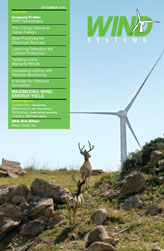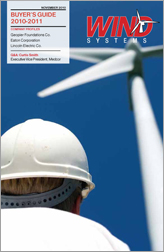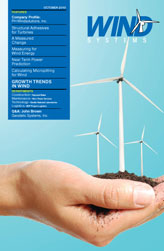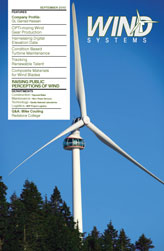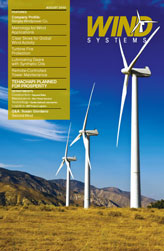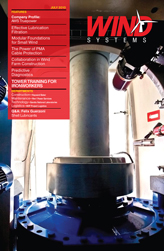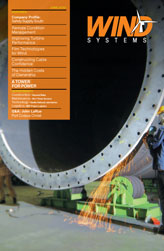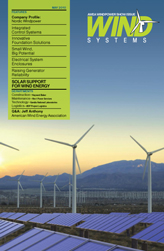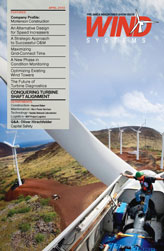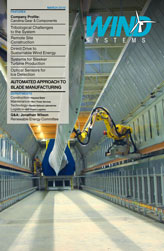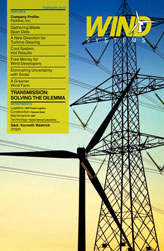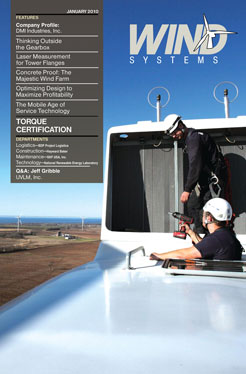We are currently updating our archive. Please check back shortly.
December 2010
Augered piles are ideally suited for use in wind tower applications
Used successfully on many types of structures, including high-rise buildings and nuclear power plants, augered piles are ideally suited for use in wind tower applications.
Most large-scale wind farms are remote, making theft and vandalism a concern
By their very nature, most large-scale wind farms are fairly remote, making theft and vandalism a very real concern. Here are some ways to deter the damage.
Wind industry must continue to improve technologies and pave the way for offshore development
As the leader of the clean energy portfolio, wind industry must continue to improve the available technologies and pave the way for markets such as offshore development.
Increased turbine production means increased transportation and logistics equipment
Meeting potential wind power goals in the U.S. will not only require increased turbine production, but also transportation and logistics equipment — and the expertise to match.
October 2010
Vibro compaction is an economical alternative to deep foundation systems
When performed properly, vibro compaction is an efficient and economical alternative to traditional deep foundation systems for many wind turbine sites with loose granular soil conditions.
Bolting techniques, part 2
In this conclusion of a two-part series, the author continues his discussion of proper bolt-tensioning techniques, providing tips on how to avoid the related failure and downtime.
Turbines affect on national security
In addition to obvious siting factors such as location and productivity, national security concerns such as the effect turbines have on radar must also be taken into consideration.
Wind projects in developing countries
The potential for wind projects in developing countries is growing in leaps and bounds, which will create logistics challenges. Here’s what you should know, and do.
September 2010
Bolting applications, part 1
If you see to the little things, the big things will take care of themselves. Thatâ’s certainly true in bolting applications, as this a two-part series makes clear.
Next-generation wind turbines will be smarter, more efficient, and more reliable than ever before
Achieving successful repowering projects
Successful repowering projects can only be achieved by considering the transportation and logistics challenges of removal and replacement of wind power structures.
August 2010
Remote monitoring allows Q&M professionals to check turbine conditions in real time
Focusing on wind turbine controls
Wind turbine blades are growing larger, so research must be focused on several multidisciplinary areas one in particular being wind turbine controls.
Having an emergency logistics plan for replacement components
July 2010
A vibrant and valuable aftermarket
Accurate computer-based design programs are crucial for high system reliability
Controlling offshore supply chain costs
Your supply chain is only as strong as the weakest link, so don’t let uncontrollable offshore supply chain costs get you in deep water.
June 2010
Remote Condition Management
Not only does the CMaS system from Moventas gather critical data while your turbines are in operation, it is analyzed by a team of experts to help ward off unexpected failure.
Constructing Cable Confidence
By gaining insights into each otherâs worlds, two companies have built a longstanding relationship from which they both benefit.
The Hidden Costs of Ownership
By understanding and addressing a host of related issues, wind turbine buyers and owners can avoid a host of hidden costs. Hereâs how.
May 2010
The technology and concept behind soil mixing
Soil mixing is an economical and efficient alternative to deep foundations for challenging sites, particularly for wind turbine foundation applications.
Turbine reliability a crucial part of success
In order to increase reliability and service life, there are a number of areas wind turbine owners can address. Hereâs what you need to know.
A look at turbine noise
Research into aero-acoustic properties will result in both the improved efficiency of wind turbines and increased siting opportunities, as the associated noise is decreased.
Harnessing the power of offshore wind
Offshore energy production is on the rise around the world, which will present logistical challenges requiring knowledgeable partners to overcome.
April 2010
The Future of Wind Turbine Diagnostics
As wind turbines increase in size, and their operating conditions become more extreme, a number of current and future tribological challenges exist.
Compaction grouting has multiple advantages
Compaction grouting is the only soil improvement technique that can be used both pre-construction and beneath an in-place foundation.
Transporting components can affect long-term profitability
How your turbine is handled prior to going online can take a definite toll on its service life, and inspections can reveal damage before the warranty period draws to a close.
Equipment shortage possible on a global scale
Demand for transport and equipment could soon outpace supply, so choose an experienced logistics solutions partner to help ensure you’re not left hanging in the wind.
March 2010
Loose ground can create foundation design challenges
When conducting site remediation, jet grouting is one technique to consider for improving poor soils without removing the existing structure.
O&M issues to increase through the decade
Pre-end of warranty inspections assess the service history of a project, vet out troubled turbines, and provide owners with an expectation for post-warranty costs.
Wind systems have gotten more effective and reliable
As designs progress and new technologies emerge, the authors present a value proposition for robust, reliable, cost-effective sensors.
Foundation ‘gaps’ can prove costly
Leave nothing to chance by utilizing standardized processes that can help reduce or eliminate the gaps in your supply chain.
February 2010
Dealing with a wind tower’s high load
Both wind and weight create tremendous forces on tower foundations, making anchoring techniques particularly critical. Here are points to keep in mind.
Test rig built to help validate bearing designs
As the market in wind turbines grows so does the demand for large, low-maintenance bearings. SKF has built a unique test rig for large bearings used in wind turbines.
Robust supply chain crucial for blades
Sandia National Laboratories initiates a program to address the challenges of manufacturing dependable, cost-effective blades for wind turbines.
Avoiding wind farm construction risks
Engineering solutions can mitigate increasingly complex infrastructure problems, allowing you to eliminate risk from your wind project before transportation begins.
January 2010
Getting turbine components where they need to be
How do you keep wind power logistics costs from blowing you away? Overcoming the hurdles of moving wind turbines from factory to project site will help.
Increasing reliability with condition monitoring
The best way to avoid turbine downtime is to follow quality maintenance procedures throughout its performance life. SKF shares the following pointers.
DOE 1.5 turbine lets NWTC conduct research
NRELâs National Wind Technology Center is working with industry partners to create the next generation of wind energy systems.
















